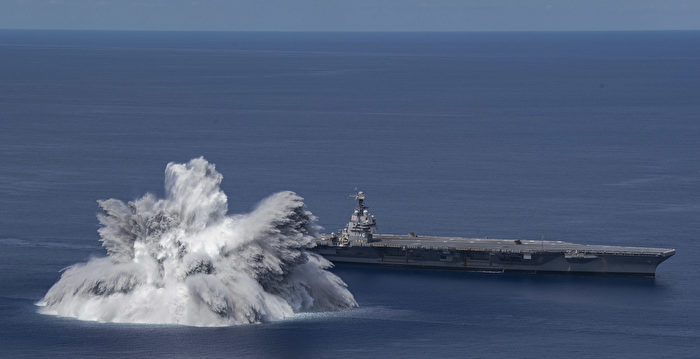[Epoch Times, June 21, 2021]On June 18, the U.S. Navy announced that the USS Gerald R. Ford (CVN 78) successfully completed the first full ship shock test (Full Ship Shock Trial). With the latest Ford-class aircraft carrier passing the last key type test, the first ship, the Ford-class aircraft carrier, has the conditions for formal deployment, which paves the way for the subsequent construction of the Ford-class aircraft carrier.
Although the design of the Ford aircraft carrier uses advanced computer modeling methods, testing and analysis to ensure that it can withstand the test of the battle environment, it is still essential to conduct explosive shock testing as the first ship to finally verify and collect the ship’s ability to withstand the test. Impact strength data.
The U.S. Navy has been conducting similar explosive shock tests on various ships for decades. The last time was in 2016, the Independence-class LCS Jackson (LCS 6) and the Freedom-class LCS Milwaukee (LCS 5) both received the same test. The San Antonio-class amphibious transport dock Ward (LPD 19) in 2008, the Wasp-class amphibious assault ship Wasp (LHD 1) in 1990, and the Ticonderoga-class cruiser USS Maobei (CG 53) in 1987, also All have undergone similar tests.
Among the Nimitz-class aircraft carriers currently in service, the USS Roosevelt (CVN 71) has also undergone shock tests. The test on June 18 was aimed at the next-generation Ford-class aircraft carrier of the U.S. Army. Thousands of pounds of explosives were detonated next to the USS Ford in the waters about 100 miles from the coast of Florida to simulate the explosion impact of the aircraft carrier under combat conditions. Various sensors installed to measure and collect impact data. According to the US Navy and government earthquake monitoring, the explosion was recorded as a magnitude 3.9 earthquake.
In April of this year, the Ford aircraft carrier successfully concluded an 18-month post-delivery test and test period, completed all necessary tests, including key carrier aircraft take-off and landing certification, and may have carried out thousands of carrier-based aircraft takeoffs. During the landing exercise, the planned improvements and maintenance were completed ahead of schedule in accordance with the requirements of the U.S. Navy to ensure the reliability of various systems.
The explosion shock test is the last key test of the Ford aircraft carrier. It is expected that later in the summer, the Ford will require six months of modernization and maintenance before it is officially deployed. According to the standards of the US military aircraft carrier, after maintenance, the aircraft carrier needs to reach the level of a newly-built ship before it can enter combat readiness and deployment.
The final construction cost of the Ford aircraft carrier exceeded US$12.8 billion, and there was also a research and development cost of about US$4.7 billion. After service, it will gradually replace the active Nimitz-class aircraft carrier. At present, the first ship, the Ford, has the conditions for combat readiness. Under Construction. The Ford aircraft carrier is equipped with more advanced AN/SPY-3 and AN/SPY-4 active electronic scanning array multi-function radars. The electromagnetic aircraft ejection system replaced the existing steam catapult, and the huge steam system was cancelled. Free up a lot of space under the deck. Ford-class aircraft carriers using electromagnetic catapults should complete 25% more aircraft ejection per day than Nimitz-class aircraft carriers.
The electromagnetic ejection system has been controversial and is suspected of insufficient reliability. A report by the US Department of Defense in early 2021 pointed out that the Ford aircraft carrier has not yet met the requirements for continuous and trouble-free ejection of 4,166 aircraft. Electromagnetic ejection is the most advanced ejection system in the world, and it requires a large amount of power supply, which can be provided by the US military’s nuclear-powered aircraft carrier. In addition to the U.S. aircraft carrier, the French carrier de Gaulle is the only nuclear-powered aircraft carrier. In theory, it can also be equipped with an electromagnetic ejection system. Aircraft carriers of other countries do not have the conditions, including the British, Italy, the Chinese Communist Party, Russia and India. Jump deck, no ejection system.
The Ford-class aircraft carrier uses more advanced technology and automation equipment, and the required crew and carrier-based aviation personnel are reduced to about 4,500. The Nimitz aircraft carrier currently in service carries about 6,000 people, which is equivalent to a 25% reduction. Although the Ford-class aircraft carrier was initially more expensive, the U.S. Navy estimates that it should save $4 billion in operating costs during its 50-year lifespan. During the test, the U.S. Navy raised major issues such as advanced weapon lift operations, and then made a series of improvements. Ford-class aircraft carriers ultimately need to verify the reliability and effectiveness of various systems in actual combat readiness deployment and even actual combat.
The explosion shock test is a key test of the main battleship of the US Navy, and it also represents the technological advancement and standardization of the US weapon research and development. The CCP may imitate the aircraft carrier of the former Soviet Union and may also understand similar tests, but it is estimated that they do not know how to proceed. More people within the CCP are concerned about how to make a fortune from it, and at the same time complete the political gifts to the CCP’s top leaders as soon as possible. From the starting line, we can see how big the gap is in the confrontation between Chinese and American aircraft carriers.
Editor in charge: Gao Yi
.
